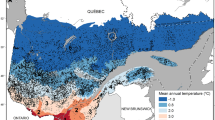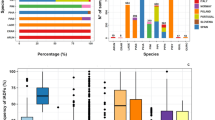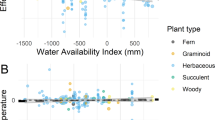Abstract
Changes in the temporal coherence between populations, which can influence their stability, resilience and persistence, remain a critical uncertainty of climate change. Recent studies have documented increasing spatial synchrony between populations at continental scales and linked it to anthropogenic climate change. However, the lack of long-term and global baseline perspectives on spatial synchrony presents a challenge to understanding the importance of these trends. Here, we show a steady rise in the spatial synchrony of annual tree growth from a global tree ring database over the past 50 years that is consistent across continents, species and environmental conditions and is unprecedented for the past millennium. Increasing growth synchrony coincided with warming trends and potentially rising synchrony in the temperature records. We discuss the potential driving mechanisms and the limitations in the interpretation of this trend, and we propose that increasing mutual dependency on external factors (also known as Moran’s effect) linked to rising global temperatures is the most likely driver of more homogeneous global growth dynamics.
This is a preview of subscription content, access via your institution
Access options
Access Nature and 54 other Nature Portfolio journals
Get Nature+, our best-value online-access subscription
$29.99 / 30 days
cancel any time
Subscribe to this journal
Receive 12 digital issues and online access to articles
$119.00 per year
only $9.92 per issue
Buy this article
- Purchase on Springer Link
- Instant access to full article PDF
Prices may be subject to local taxes which are calculated during checkout




Similar content being viewed by others
Data availability
All the data used in this study are publicly available. The tree-growth data are available via the NOAA web repository at https://www.ncdc.noaa.gov/data-access/paleoclimatology-data/datasets/tree-ring. The combined land-surface air and sea-surface water temperature anomaly data from GISTEMP Team 2018 are available via the NASA repositories at https://datahub.io/core/global-temp#data-cli. The annual precipitation and mean temperature data from the Princeton Reanalysis data version 2 are available at http://hydrology.princeton.edu/data.pgf.php. The nitrogen deposition data from the ISIMIP2b input data are available at https://www.isimip.org/gettingstarted/details/24/. The ENSO, SOI and NAO time series from NOAA are available at ftp://ftp.ncdc.noaa.gov/pub/data/paleo/treering/reconstructions/enso-li2013.txt and https://www.esrl.noaa.gov/psd/gcos_wgsp/Timeseries/. The version of the data used in this manuscript is available at https://figshare.com/articles/dataset/Data_for_Evidence_of_unprecedented_rise_in_growth_synchrony_from_global_tree_ring_records_/12623501.
Code availability
The R script used to analyse the data and generate the graphs is available at https://figshare.com/articles/dataset/Annex_5_script/12623492. The graphs were generated in R and then imported to Inkscape for final formatting.
Change history
18 May 2021
A Correction to this paper has been published: https://doi.org/10.1038/s41559-021-01475-3
References
Thomas, C. D. et al. Extinction risk from climate change. Nature 427, 145–148 (2004).
Alexander, J. M., Diez, J. M. & Levine, J. M. Novel competitors shape species’ responses to climate change. Nature 525, 515–518 (2015).
Seidl, R., Schelhaas, M.-J., Rammer, W. & Verkerk, P. J. Increasing forest disturbances in Europe and their impact on carbon storage. Nat. Clim. Change 4, 806–810 (2014).
Post, E. & Forchhammer, M. C. Synchronization of animal population dynamics by large-scale climate. Nature 420, 168–171 (2002).
Koenig, W. D. & Liebhold, A. M. Temporally increasing spatial synchrony of North American temperature and bird populations. Nat. Clim. Change 6, 614–617 (2016).
Shestakova, T. et al. Forests synchronize their growth in contrasting Eurasian regions in response to climate warming. Proc. Natl Acad. Sci. USA 113, 662–667 (2016).
Black, B. A. et al. Rising synchrony controls western North American ecosystems. Glob. Change Biol. 24, 2305–2314 (2018).
Heino, M. Noise colour, synchrony and extinctions in spatially structured populations. Oikos 83, 368–375 (1998).
Liebhold, A., Koenig, W. D. & Bjørnstad, O. N. Spatial synchrony in population dynamics. Annu. Rev. Ecol. Evol. Syst. 35, 467–490 (2004).
Gouhier, T. C., Guichard, F. & González, A. Synchrony and stability of food webs in metacommunities. Am. Nat. 175, E16–E34 (2010).
Elton, C. S. Periodic fluctuations in the numbers of animals: their causes and effects. Br. J. Exp. Bot. 2, 119–163 (1924).
Moran, P. A. P. The statistical analysis of the Canadian lynx cycle. Aust. J. Zool. 1, 291–298 (1953).
Loreau, M. & de Mazancourt, C. Species synchrony and its drivers: neutral and nonneutral community dynamics in fluctuating environments. Am. Nat. 172, E48–E66 (2008).
Buma, B. et al. The value of linking paleoecological and neoecological perspectives to understand spatially-explicit ecosystem resilience. Landsc. Ecol. 34, 17–33 (2018).
Hughes, B. B. et al. Long-term studies contribute disproportionately to ecology and policy. BioScience 67, 271–281 (2017).
Gajewski, K., Viau, A. E., Sawada, M., Atkinson, D. E. & Fines, P. Synchronicity in climate and vegetation transitions between Europe and North America during the Holocene. Clim. Change 78, 341–361 (2006).
Zhao, S. et al. The International Tree-Ring Data Bank (ITRDB) revisited: data availability and global ecological representativity. J. Biogeogr. https://doi.org/10.1111/jbi.13488 (2018).
Babst, F., Poulter, B., Bodesheim, P., Mahecha, M. D. & Frank, D. C. Improved tree-ring archives will support earth-system science. Nat. Ecol. Evol. 1, 0008 (2017).
Cook, E. R. & Peters, K. Calculating unbiased tree-ring indices for the study of climatic and environmental change. Holocene 7, 361–370 (1997).
Gedalof, Z. E. & Berg, A. A. Tree ring evidence for limited direct CO2 fertilization of forests over the 20th century. Glob. Biogeochem. Cycles 24, GB3027 (2010).
Gazol, A., Camarero, J. J., Anderegg, W. R. L. & Vicente-Serrano, S. M. Impacts of droughts on the growth resilience of Northern Hemisphere forests. Glob. Ecol. Biogeogr. 26, 166–176 (2016).
Pomara, L. Y. & Zuckerberg, B. Climate variability drives population cycling and synchrony. Divers. Distrib. 23, 421–434 (2017).
Briffa, M. et al. Trends in recent temperature and radial tree growth spanning 2000 years across northwest Eurasia. Phil. Trans. R. Soc. B 363, 2271–2284 (2008).
Ponocná, T. et al. Deviations of treeline Norway spruce radial growth from summer temperatures in East-Central Europe. Agric. Meteorol. 253, 62–70 (2018).
Shestakova, T. A., Gutiérrez, E., Valeriano, C., Lapshina, E. & Voltas, J. Recent loss of sensitivity to summer temperature constrains tree growth synchrony among boreal Eurasian forests. Agric. Meteorol. 268, 318–330 (2019).
Schurman, J. S. et al. Large-scale disturbance legacies and the climate sensitivity of primary Picea abies forests. Glob. Change Biol. 24, 2169–2181 (2018).
Schweingruber, F. H. Tree Rings: Basics and Applications of Dendrochronology (Springer Science & Business Media, 1996).
Speer, J. H. Fundamentals of Tree-Ring Research (Univ. of Arizona Press, 2010).
Savolainen, O., Pyhäjärvi, T. & Knürr, T. Gene flow and local adaptation in trees. Annu. Rev. Ecol. Evol. Syst. 38, 595–619 (2007).
Ripa, J. Analysing the Moran effect and dispersal: their significance and interaction in synchronous population dynamics. Oikos 89, 175–187 (2000).
Hopson, J. & Fox, J. W. Occasional long distance dispersal increases spatial synchrony of population cycles. J. Anim. Ecol. 88, 154–163 (2019).
Johnson, C. A. et al. Effects of temperature and resource variation on insect population dynamics: the bordered plant bug as a case study. Funct. Ecol. 30, 1122–1131 (2016).
Parmesan, C. & Yohe, G. A globally coherent fingerprint of climate change impacts across natural systems. Nature 421, 37–42 (2003).
St. George, S. The aberrant global synchrony of present-day warming. Nature 571, 483–484 (2019).
Neukom, R. et al. Consistent multidecadal variability in global temperature reconstructions and simulations over the common era. Nat. Geosci. 12, 643–649 (2019).
Babst, F. et al. Twentieth century redistribution in climatic drivers of global tree growth. Sci. Adv. 5, eaat4313 (2019).
Giguère-Croteau, C. et al. North America’s oldest boreal trees are more efficient water users due to increased [CO2], but do not grow faster. Proc. Natl Acad. Sci. USA 116, 2749–2754 (2019).
Duncan, A. B., Gonzalez, A. & Kaltz, O. Dispersal, environmental forcing, and parasites combine to affect metapopulation synchrony and stability. Ecology 96, 284–290 (2015).
Girardin, M. P. et al. No growth stimulation of Canada’s boreal forest under half-century of combined warming and CO2 fertilization. Proc. Natl Acad. Sci. USA 113, E8406–E8414 (2016).
Manzanedo, R. D. et al. Increase in CO2 concentration could alter the response of Hedera helix to climate change. Ecol. Evol. 8, 8598–8606 (2018).
Venter, O. et al. Sixteen years of change in the global terrestrial human footprint and implications for biodiversity conservation. Nat. Commun. 7, 12558 (2016).
Pederson, N. et al. Long-term drought sensitivity of trees in second-growth forests in a humid region. Can. J. Res. 42, 1837–1850 (2012).
Kug, J. S., An, S. I., Ham, Y. G. & Kang, I. S. Changes in El Niño and La Niña teleconnections over North Pacific–America in the global warming simulations. Theor. Appl. Clim. 100, 275–282 (2010).
Rahmstorf, S. & Coumou, D. Increase of extreme events in a warming world. Proc. Natl Acad. Sci. USA 108, 17905–17909 (2011).
Cai, W. et al. Increasing frequency of extreme El Niño events due to greenhouse warming. Nat. Clim. Change 4, 111–116 (2014).
Fischer, E. M., Beyerle, U. & Knutti, R. Robust spatially aggregated projections of climate extremes. Nat. Clim. Change 3, 1033–1038 (2013).
Trenberth, K. E., Fasullo, J. T. & Shepherd, T. G. Attribution of climate extreme events. Nat. Clim. Change 5, 725–730 (2015).
Thurm, E. A. et al. Alternative tree species under climate warming in managed European forests. Ecol. Manage. 430, 485–497 (2018).
Manzanedo, R. D. & Pederson, N. Towards a more ecological dendroecology. Tree Ring Res. 75, 152–159 (2019).
Klesse, S. et al. Sampling bias overestimates climate change impacts on forest growth in the southwestern United States. Nat. Commun. 9, 5336 (2018).
Ettinger, A. K., Kevin, R. F. & HilleRisLambers, J. Climate determines upper, but not lower, altitudinal range limits of Pacific Northwest conifers. Ecology 92, 1323–1331 (2011).
Grissino-Mayer, H. D. & Fritts, H. C. The International Tree-Ring Data Bank: an enhanced global database serving the global scientific community. Holocene 7, 235–238 (1997).
Wilson, R. et al. Last millennium Northern Hemisphere summer temperatures from tree rings. Part I: the long term context. Quat. Sci. Rev. 134, 1–18 (2016).
Cook, B. I., Anchukaitis, K. J., Touchan, R., Meko, D. M. & Cook, E. R. Spatiotemporal drought variability in the Mediterranean over the last 900 years. J. Geophys. Res. Atmos. 121, 2060–2074 (2016).
Charney, N. D. et al. Observed forest sensitivity to climate implies large changes in 21st century North American forest growth. Ecol. Lett. 19, 1119–1128 (2016).
Bunn, A. G. A dendrochronology program library in R (dplR). Dendrochronologia 26, 115–124 (2008).
R: A Language and Environment for Statistical Computing Version 3.5.0 (R Core Team, 2017).
Sheffield, J., Goteti, G. & Wood, E. F. Development of a 50-yr high-resolution global dataset of meteorological forcings for land surface modelling. J. Clim. 19, 3088–3111 (2006).
Lamarque, J.-F. et al. The Atmospheric Chemistry and Climate Model Intercomparison Project (ACCMIP): overview and description of models, simulations and climate diagnostics. Geosci. Model Dev. 6, 179–206 (2013).
GISTEMP Team GISS Surface Temperature Analysis (GISTEMP) Version 4 (NASA Goddard Institute for Space Studies, accessed 2 July 2018); https://data.giss.nasa.gov/gistemp/
Acknowledgements
We thank all the generous contributors of the ITRDB; without them this work would not be possible. We thank T. Mandra and J. Maxwell for providing insightful comments in earlier versions of this manuscript. This work was supported by the Swiss National Science Foundation (SNF) through the Early Postdoc.Mobility scheme, and the Harvard Forest.
Author information
Authors and Affiliations
Contributions
R.D.M., J.H. and N.P. conceived and designed the main research questions and methodology. R.D.M. and T.T.R. analysed the data. R.D.M. created the figures and the first draft of the manuscript. All authors contributed to the interpretation and writing in successive versions of the manuscript.
Corresponding author
Ethics declarations
Competing interests
The authors declare no competing interests.
Additional information
Publisher’s note Springer Nature remains neutral with regard to jurisdictional claims in published maps and institutional affiliations.
This article has been retracted. Please see the retraction notice for more detail:https://doi.org/10.1038/s41559-021-01475-3
Supplementary information
Supplementary Information
Supplementary Notes 1–4 and Figs. 1–12.
About this article
Cite this article
Manzanedo, R.D., HilleRisLambers, J., Rademacher, T.T. et al. RETRACTED ARTICLE: Evidence of unprecedented rise in growth synchrony from global tree ring records. Nat Ecol Evol 4, 1622–1629 (2020). https://doi.org/10.1038/s41559-020-01306-x
Received:
Accepted:
Published:
Issue Date:
DOI: https://doi.org/10.1038/s41559-020-01306-x
This article is cited by
-
RETRACTED ARTICLE: Tree growth in sync
Nature Ecology & Evolution (2020)



